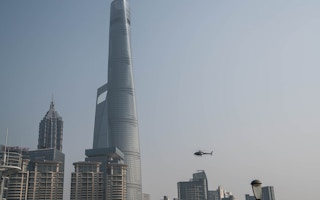In 2030, Asia will hold two-thirds of the global middle class with most of them condensed along coast lines. This region is projected to see living areas for 650 million people submerged or exposed to flooding by 2100, and is highly vulnerable to climate change.
Yet, the focus on industrial and economic development over the past decades in Asia did not, for the longest time, connect environmental challenges with development-at-all-costs. Most people do not see themselves as having the personal power or influence to make a compelling difference in climate change.
But many of the design decisions made every day have a climate implication; each one can help promote a low-carbon future that does not rely on fossil fuels. Those who create the products and built environments of everyday life—from mechanical engineers to architects—have an important role to play by designing for climate change.
A small country like Singapore accounts for just 0.11 per cent of global emissions, while representing 2.2 per cent of global trade. Even so, the city has pledged to reduce its emissions intensity by 36 per cent by 2030. Last year, Singapore ranked second among global cities for green buildings—showing that policy makers, business leaders, designers, architects and engineers have started to incorporate sustainability into their plans and operations.
Design and climate change
Designers and engineers can address the climate change challenge by designing for higher productivity. Increased productivity requires maximising value (output) while minimising costs (inputs, such as energy and material resources). In terms of architecture and construction, that could mean designing buildings that use less energy. On the manufacturing side, it could be designing products that last longer and use less virgin materials. One thing is certain: Energy and resource productivity is paramount in all forms of design.
Designers and engineers who are aiming for higher productivity—and thus addressing climate change—typically employ these five approaches:
- Ask energy productivity questions upfront
It is important to raise questions such as “What is the energy implication of this design decision?” or “How will this choice increase energy and resource productivity?” early and often to ensure that designers and engineers lower costs while adding value. This sets the precedent for continued sustainable design choices throughout the life of the project. Those small decisions add up to big impacts.
Shanghai Tower, China’s tallest building, saved 25 per cent of its material costs because the architects focused on how to lighten the structure while maintaining its strength. They did that by analysing how wind strikes the building and then shaping it into a twist cutting through the wind. Those decisions shaped the project right from the beginning and were not a “green” afterthought. - Model, simulate, and repeat
Simulation technology to model and test alternatives now makes it easy to test early design decisions. Chinese solar start-up company Pionovasion discovered this first-hand. Using thin-film technology, the company invented the solar cloth that can be moulded into different shapes and sizes, bringing solar power to everyday life for millions of people. By installing a solar energy station on the roof of a primary school in a remote area in Hebei Province, an area with unreliable access to electricity, Pionovasion supplied up to 90 per cent of the school’s electricity needs and taught the wider community about sustainable energy.
By using simulation tools available, designers and engineers can run the early analyses that yield similar energy, material, or time savings—while saving money. But project stakeholders must know the gains they can expect and even demand sustainable practices throughout the design and engineering process. - Take the long-term view
Designers and engineers must make long-term decisions that consider the product or project life cycle. Industrial fan manufacturer, Howden France, analysed its fan wheels accounting for fatigue and adjusting their thickness and weight. By optimising the wheels’ weight, Howden cut the fan’s inertia, leading to better lifetime performance and reducing the power required for the motor. And that led to lower operating costs—a big win for customers.
Designing for repair is key; the most sustainable product is often the one that lasts the longest. HP knew this when it released the Elite x2 1012 G1 tablet. The company offers online repair documentation and replacement parts for users to repair their units themselves. - Consider the whole system
Designers and engineers who use the process of whole-systems thinking consider the inter-relationships between complex systems, instead of focusing on an individual part of the system. Most of the challenges we face in society show a set of interconnected issues that cannot be solved in isolation. By considering the whole system, the most important opportunities often arise, and can be an influence early in the process.
The team behind the Floatility’s network-enabled electric vehicle applied whole-systems thinking to the goal of producing an affordable, fast, safe method of personal transportation that runs on a small amount of energy. By considering all the interdependent factors and addressing issues up front, they delivered a lightweight, solar-powered short distance transportation with zero-emissions.
“
Many of the design decisions made every day have a climate implication; each one can help promote a low-carbon future that does not rely on fossil fuels.
- Communicate
Designing for higher productivity will save costs for customers and deliver more value. Designers and engineers should educate their clients, suppliers, subcontractors, and colleagues that choices can make a real difference to the bottom line and to climate change.
Global architecture and engineering firms have taken significant steps in this area by signing on to the Architecture 2030 Challenge. These are commitments for the global design build community to plan and design cities, towns, development and buildings to low carbon and carbon neutral standards by 2030. Architecture firms in China signed the country’s equivalent, the China Accord, a national framework towards the progress to meeting the Architecture 2030 Challenge.
Simply put, sustainable design is good design. If more designers and engineers commit to asking efficiency questions early, using simulation and analysis tools, and taking a long-term and whole-system view, the climate change needle will move. And the best part is, they’ll be reducing emissions while increasing value for their customers.
Lynelle Cameron is VP Sustainability at Autodesk and the CEO of Autodesk Foundation.


















